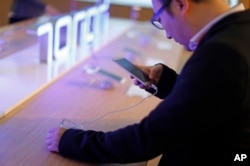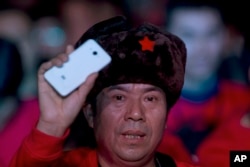Apple’s new iPhone SE has already racked up millions of pre-orders in China, as the company aims to capture more consumers in a country where domestic manufacturers are already facing stiff competition.
The iPhone SE is the cheapest smart phone Apple has ever produced, and is a new attempt by the company to attract buyers seeking a lower price point in the developing world.
Jason Low, an analyst with Canalys, said previously Apple focused on consumers seeking a high end user experience, at a premium price.
High-end market segment
“Apple is aiming for the premium segment. The price is really different, and the segment of the customers is really different. So each of them, has their own appeal. For example Apple is a brand that provides a very high end experience,” he said.
Smaller screen
Pre-orders for the iPhone SE began last week in North America, Europe and Asia. The phone will become available to customers in another 47 countries later this spring. The iPhone SE includes many of the features in Apple’s iPhone 6s, but the screen is smaller, at only 4 inches (10 centimeters), and the price is much cheaper. The 16 gigabyte version costs $399, and the 64 gigabyte is $499.
Sales have stagnated at Apple. In January the company forecast a drop in sales for Apple products, which would be the first decline since 2003. To boost purchases the company is targeting new customers in China, its biggest market, and India, its fastest growing.
James Roy, a Business Analyst at China Market Research Group, said Apple is now challenging Chinese smartphone brands in their home market.
“At this point you have a number of Chinese smart phones that have gotten very good at offering good smartphones at the lower to middle end of the market,” he said.
Competition, challenge for Chinese companies
Chinese smartphone companies are already facing stiff competition domestically, with a few key brands dominating the market. Just four brands - Huawei, Xiaomi, Oppo and Vivo – captured 45 percent of the Chinese smartphone market last year. The number of Chinese brands has dwindled over the last couple of years, and analysts expect further consolidation.
As Apple aims to attract China’s rising middle class, these Chinese brands are increasingly seeking marketshare abroad. Xiaomi says it will focus on India and the Chinese domestic market for the next year or so, before targeting the U.S.
Teng Bingsheng, an associate professor of strategic management at the Cheung Kong Graduate School of Business, said Chinese companies will have to change the perception of their brands with overseas consumers.
“The problem is that the brands are not as well known, and it’s going to take a long time for the Chinese cell phone brands to be perceived as first class cell phones,” he said.
Xiaomi is widely referred to as “China’s Apple,” and with handsets priced as low as $200, it may someday succeed in winning over Apple consumers in the U.S.









